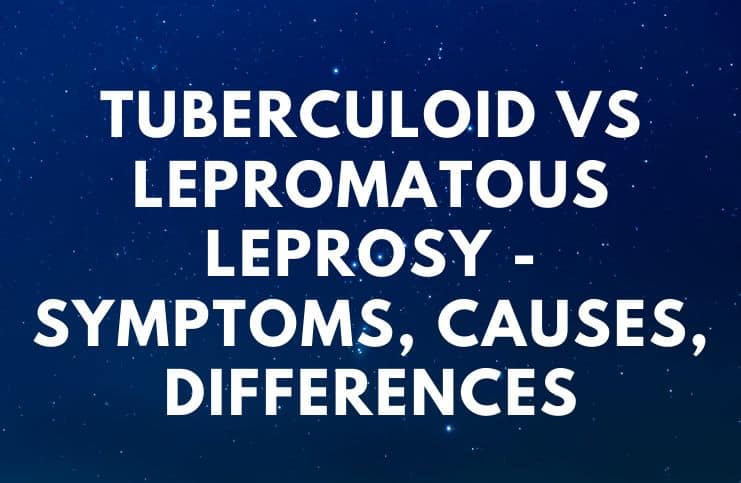Tuberculoid vs Lepromatous Leprosy – Symptoms, Causes, Differences:
Tuberculoid Leprosy (TL)
It is a form of leprosy that is characterized by skin lesions that are asymmetrically distributed with well-demarcated edges and few lesions.
TL starts with localized skin lesions, which are at first flat and red, however, they enlarge and develop irregular shapes with elevated, indurated, depressed pale centers, and hyperpigmented margins.
An individual with TL only exhibits a few lesions. The infection is mild and only mildly contagious.
Symptoms
TL causes a rash, consisting of one or more flat and whitish areas on the skin. Other symptoms include:
- ulcers on the soles of the feet;
- curling of the thumb and fingers, which is caused by paralysis of small muscles in the hand;
- stuffy nose and nosebleeds;
- enlarged nerves, particularly in the knees and elbows;
- eye problems;
- numbness in the hands, legs, feet, and arms;
- muscle weakness;
- patches of skin with decreased sensation, like – pain, touch, and heat.
Causes
It is a chronic infectious disease caused by Mycobacterium leprae.
After exposure to leprosy and the incubation period, the disease may fluctuate between different stages depending on the patient’s response to therapy or to cell-mediated immune response.
Risk Factors
Risk factors include the following:
- bathing in open water bodies;
- overcrowding;
- use of the same bed linen for prolonged periods of time;
- malnutrition.
Diagnosis
The bacteria can be seen with a microscope in a skin smear using a special stain.
Treatment
Treatment can last between 6-12 months, sometimes longer. The disease can be cured with multi-drug therapy, a combination of 3 antibiotics – clofazimine, rifampin, and dapsone.
Prognosis
Because the disease pursues an extremely slow course, spanning several decades, most affected individuals die with leprosy rather than of it.
Lepromatous Leprosy (LL)
It is characterized by multiple skin lesions that are smaller than those observed in TL. Also, it affects the nerves, skin, and other organs. This form of leprosy is more contagious.
Symptoms
Lepromatous leprosy causes many small bumps or raised rashes on the skin. Other symptoms may include:
- eye problems which may lead to blindness;
- numbness or lack of feeling in the arms, feet, hands, and legs;
- severe pain;
- muscle weakness or paralysis, particularly in the feet and hands;
- thick, stiff or dry skin;
- enlarged nerves, particularly around the elbow and knee;
- ulcers on the soles of the feet;
- lesions that do not heal after several months;
- skin lesions that are lighter than the patient’s normal skin color;
- lesions on the body that are not as sensitive to heat, touch, or pain;
- a stuffy nose;
- nosebleeds.
Note – lepromatous leprosy is more disfiguring than tuberculoid leprosy.
Causes
The disease results from the failure of Th1 cell (a type of T helper cell) activation that is required to eradicate the mycobacteria.
READ MORE: Cyclothymia vs Dysthymia – Differences
Risk Factors
Risk factors for contracting the disease include:
- genetic variants of the NOD2-mediated signaling pathway;
- tattoos;
- Armadillo contact;
- age between 5 and 15 or over 30;
- living in an endemic region (Angola, Central African Republic, Brazil, Federated States of Micronesia, Democratic Republic of Congo, Madagascar, India, Kiribati, Republic of Marshall Islands, Mozambique, United Republic of Tanzania, Nepal);
- close contact with an untreated, active multibacillary disease patient.
In addition, people who are immunosuppressed could be more at risk of developing the disease. However, for unknown reasons, this increased risk does not apply to individuals with HIV.
Diagnosis
Your healthcare provider may perform a lepromin skin test to determine the form of leprosy. Also, he will conduct a physical exam to look for the symptoms of the disease.
READ MORE: Hypersomnia vs Narcolepsy
Treatment
Treatment is by multidrug therapy in a combination of Rifampicin and Dapsone for paucibacillary leprosy for 180 days. In addition, clofazimine (an antileprosy agent with anti-inflammatory and anti-mycobacterial activities) is prescribed, and the treatment is for one year.
Note – individuals with both leprosy and HIV can find that their condition worsens when they start the treatment.
Prevention
Because close and prolonged contact is needed for transmission, people who travel into areas where the disease is present have a low risk of contracting leprosy.
In addition, it is recommended to exclude people with the disease from preschool, childcare, work, and school, until approval to return has been given by an infectious healthcare professional.
READ MORE: Malar Rash vs Rosacea
Bottom Line – Tuberculoid vs Lepromatous Leprosy
Tuberculoid leprosy is a form of leprosy that is characterized by one or more anesthetic patches or hypopigmented skin macules, where skin sensations are lost due to damage to the peripheral nerves, which have been attacked by the human host’s immune cells.
Lepromatous leprosy is another form of leprosy that is characterized by pale macules in the skin.
In conclusion, LL owns a poor cell-mediated immunity that results in an extensive spreading of the infection all over the body, while TL is characterized by a relatively high cell-mediated immunity and restricted pathogenic growth.
In LL the skin lesions appear as brown or yellow infiltrated nodules which affect the mucous membranes of the nose, eyes, and throat. Also, LL is the more easily spread of the two. On the other hand, TL is the more benign type, and the skin lesions appear as light red or purplish spots.
Both forms of leprosy cause peripheral nerve damage and skin sores. However, LL is more severe and causes large, disfiguring lumps and bumps on the skin.
According to a 1996 study that was done at the Dermatology Service, Universidad del Valle, Cali, Colombia, the two distinct forms of leprosy are capable of responding to a polyclonal T-lymphocyte stimulus like anti-CD3.
READ THIS NEXT: Episcleritis vs Conjunctivitis (Pinkeye)
References https://www.ncbi.nlm.nih.gov/pmc/articles/PMC4290185/ http://www.jdrntruhs.org/article.asp?issn=2277-8632;year=2018; https://www.ncbi.nlm.nih.gov/pubmed/895075
